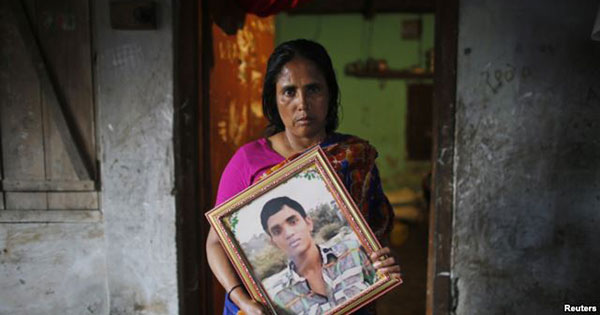Published by the Voice of America on Wednesday, 6 May 2015.
Controversy Surrounds Effort to Compensate Bangladesh Building Collapse Victims
Shaikh Azizur Rahman
May 06, 2015 KOLKATA

Two years after the collapse of Dhaka’s Rana Plaza building, in which more than 1,100 garment factory workers died, millions of dollars have been paid to thousands of affected people, but the disbursement is not without controversy.
Soon after the tragedy, the Bangladesh government and global clothing companies collected money for two separate funds to compensate the survivors and the dependents of those killed in the collapse of the nine-story building.
Bangladesh’s commercial banks and other local sources contributed $16 million to the prime minister’s Relief and Welfare Fund following the disaster. Transparency International Bangladesh (TIB)- the Bangladesh chapter of the global anti-corruption watchdog last month reported that the prime minister’s fund has disbursed just $2.48 million of that total.
Another fund, called Rana Plaza Donors’ Trust Fund, which was set up exclusively for Rana Plaza victims, drew $27 million in contributions from some 30 European and American clothing brands, some Bangladeshi garment manufacturers and the PM’s fund.
The Rana Plaza Claims Administration (RPCA), which manages the trust fund, says that so far it has disbursed some $19.63 million among the victims.
Officials are still trying to determine the final number of people killed in the tragedy, because the bodies of 159 people reported missing have never been found. That could bring the total number killed to about 1,300.
Trust fund shortfall
The Rana Plaza Donor’s Trust Fund says it is about $3 million short of the $30 million it estimates it needs to compensate all victims of the tragedy.
Transparency International Bangladesh executive director Iftekhar Zaman is calling on the Prime Minister’s fund to make up the difference.
“Although the Prime Minister’s fund received contributions of $ 16 million for the Rana Plaza tragedy victims, only $ 2.48 million was disbursed (through trust fund). In fact, the whole amount of $ 16 million is meant for use as relief to those victims,” Zaman said.
A spokesman for the Prime Minister’s Office’s has defended its donation record, saying the collections are not exclusively for the Rana Plaza victims, and could go to other people in need. But officials have provided little information about the disbursement of the funds, says Transparency. The group says the government so far has failed to even provide a list of who has already been compensated.
Blame game
For the families of workers killed in the factory, the compensation amount varies depending on their salary, and the number and age of their dependents. Administrators say the amount ranges from around $6,425 to $12,850. Several workers in highly placed positions were compensated more than $32,000.
Phil Robertson, Asia Deputy Director of Human Rights Watch, partly blames some international garment brands who had operations in the garment factories, but have failed to meet expectations on donations to the relief fund.
“But it also indicates yet another appalling abdication of responsibility by the Bangladesh garment factory industry itself, since their trade group the BGMEA (Bangladesh Garment Manufacturers and Exporters Association) is not contributing to the fund,” he said.
The Centre for Policy Dialogue (CPD), a Dhaka-based think-tank, said that although the government and outside groups have improved working conditions in many garment factories over the past two years, the slow payments process has meant that survivors and the victims’ families are being denied financial support which could help rehabilitate them.

